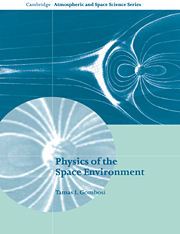Book contents
Chapter 11 - The Sun
Published online by Cambridge University Press: 22 October 2009
Summary
The Sun is an ordinary star of spectral type G2V with magnitude of 4.8. However, it is the only star we have in our immediate vicinity and it is the source of most of the energy that controls physical phenomena in our space environment. The Sun is also a living, dynamic star with varying activity as demonstrated in Figure 11.1. Changes in solar activity result in many important phenomena in the space environment, ranging from flares, to coronal mass ejections, to geomagnetic storms. The fundamental physical properties of the Sun are given in Table 11.1.
The Sun consists primarily of hydrogen (90%) and helium (10%). Elements such as C, N, and O constitute about 0.1% of its mass. The interior can be divided into four zones (see Figure 11.2):
The core. This is the high density, high temperature region at the center of the Sun, where thermonuclear energy production takes place. The core extends from the center to about R⊙/4 (1/64-th of the Sun's volume), but it contains about half of the solar mass. Practically all of the Sun's energy production takes place in this region.
The radiative zone. The energy produced in the core is transported through the core and the radiative zone by gamma ray diffusion. The gamma rays are scattered, absorbed, and reemitted many times before they reach the outer edge of the radiative zone.
[…]
- Type
- Chapter
- Information
- Physics of the Space Environment , pp. 211 - 235Publisher: Cambridge University PressPrint publication year: 1998



